WiSE Program at Alfred University
Women in Science and Engineering (WiSE) at Alfred Unveristy is aimed to encourage women to actively participate in all disciplines of engineering sciences. This program hosts and invites female students and parents to visit Alfred University to partake in demonstrations and activities that highlight the potential for engineering as a career choice. with respect to the Biomaterials Engineering Laboratory, students and parents can partake in demonstrations relating to biomaterials processing, corrosion studies and in addition to observing the growth of living cells, used to determine the suitability of novel materials for medical applications. Specificially, the demonstrations in Dr. Wrens laboratory includes:
Glass Melting: This demonstration shows how glasses are synthesized from high temperature processing. Glass, from their molten state at 1500C is poured and cooled on a graphite plate. Bioactie glasses are currently used in medical applications to replace damaged or diseased bone bone tissue that has been removed, leaving a open void. Bioactive glass can be designed to dissolve when in contact with physiological fluids, with the ionic dissolution products promoting host tissue regeneration.

Glass Pouring at Alfred University.
Corrosion Laboratory: A driving principle behind how biomaterials improve human health is related to how medical materials biodegrade and influence host tissues. An instrument call Inductively Couples Plasma Optical Emission Spectroscopy (ICP-OES) can be used to detect specific concentration of ions that are released from medical material to determine their toxicity or suitability to be considered for contact with living tissues.
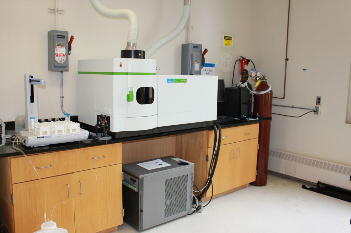
ICP-OES Instrument at Alfred University.
Cell Culture & Microbiology: The cell culture laboratory houses various mammalian cell llines including fibroblasts, bone cells (osteoblasts) and cancer cell lines (osteosarcoma). Ionic dissolution products from materials can be exposed to cell lines to determine if they increase the proliferation rate of the cell line, or to determine if they are toxic, which aims to determine whether a material will prove useful or harmful when implanted into the human body.

Fibroblast Cells growing in the Biomaterials Laboratory.
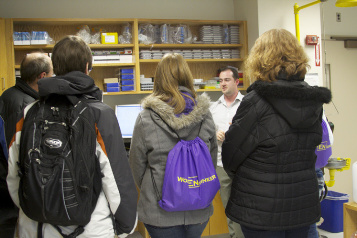
Demonstrating cell culture techniques with students for women in science and engineering day.
See Also:
International Outreach Program
Triton ceramics is a local social enterprise that was developed by Mr. Nick Rozard with the aim to fabricate ceramic particle based water filters that can be used to clean water for human consumption. Mr. Rozard is a graduate of the ceramic engineering program at Alfred University who has established collaborations with agencies such as The Society for Health Educations, Environment and Peace (SHEEP) Indonesia. Sheep is a non-profit organization that is interested in supplying ceramic based water filter to the local people in Indonesia. In 2008, Friends Peace Teams to Asia West Pacific collaborated with SHEEP to bring Mr. Rozard to Yogyakarta, Indonesia for two weeks to conducts training on producing the ceramics. Since the trip to Indonesia, Mr. Rozard has been working to further develop the technology which includes coating the ceramic particles of varying size distribution, with silver (Ag), a known antibacterial agent. The packing of the ceramic particles of differing sizes results in a controlled porous network where the water passes through during filtration. The Ag coating on the glass particles cn eliminate harmful bacteria like E. coli thats can survivie and be transmitted through drinking water.
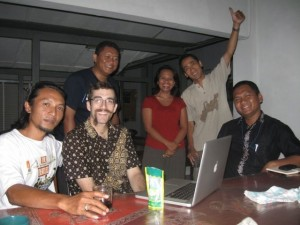
Mr. Rozard and SHEEP staff gathering in Yogyakarta, Indonesia.
To further develop his technology, Mr. Rozard has established strong connections with faculty members at Alfred University. Professor William M. Carty is a Professor of Ceramic Engineerig and Materials Science and is chair of the Ceramic Engineering Program at Alfred University and has been working on silver containing water filters for many years. Prof. Carty is more than willing to support Mr. Rozards effort and provide insight regarding his work on water filter theory.
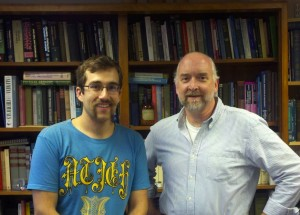
Mr. Rozard and Prof William Carty.
Mr. Rozard and Prof. Carty requested the assistance of the Biomaterials laboratory which houses bacteria relevant to this project. Dr. Anthony W. Wren is an Assistant Professor of Biomaterials at Alfred University and has investigated silver coatings on bioactive glasses to eradicate harmful bacteria that can cause infection in bone voids post surgery. In addition to forming a collaboratoration to further this technology, this partnership also helped support a senior thesis student project, conducted betweent the Ceramic Engineering and Biomaterials Laboratory at Alfred University. Mr. Nathan Halverson (senior student) completed his senior project entitled "Evaluation of Silver Treated Shale as Packed Bed Water Filter" in december 2012.
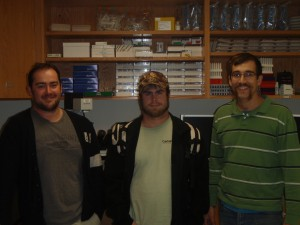
Dr. Wren, Mr. Nathan Halverson and Mr. Rozard in the Biomaterials Laboratory at Alfred University.
The ultimate goal of Mr. Rozards efforts is to provide open source technology that can be freely available to people of Indonesia in addition to others that this technology may be applicable.
See Also:
Friends Peace Teams to Asia West Pacific
High School Outreach Efforts
Alfred Universities Biomaterials department established a connection to a high school in Belfast, New York, through an organization called the Children Youth Learning Initative (CYLI). This outreach project involved the participation of Alfred University administration Elizabeth Vistz and Emilie Carney. This outreach program formed collaboration between faculty at Alfred University, Dr. Anthony Wren, and a teacher at Belfast Central Highschool, Mr. Josh Hazleton. This outreach program is designed to encourage the participation of high school students in Science and Engineering (STEM) subjects. The program consists of four (2 hour) visits, where students from Belfast Central High School travel to Alfred University to conduct research projects that are current areas of interest within the medical and bioengineering disciplines.

Dr. Wren giving an introduction lecture to Belfast Highschool students.
The following is a breakdown of the outreach program by visit, and each visit will begin with a 20-25 min lecture on the lab topic:
Visit 1: Antibiotic doped bone cements. Students will incorporate an antibiotic of their choice (vancomycin, erthromycin, amphotericin B) into a dental cement (permline repair). Students can select which microbes to implant their antibiotic doped cement into, microbes available include, E. coli, S. epidermidis and C. albican. Also in this session students will produce samples for mechanical testing.
Visit 2: Students will measure the inhibition zones of the bacterial/fungal plates, first by hand and second using an automated system, the symbiosis protocol 3 colony counter. Students will then conduct mechanical testing, specifically compression testing, on their samples to determine the maximum load at failure.
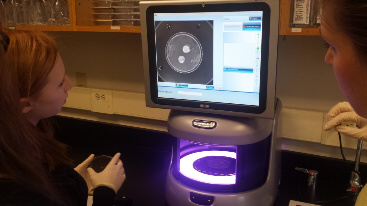
Highschool students using the Protocol 3 Colony Counter.
Visit 3: During this visit, students will have the oppertunity to use instruments to looks at their own samples. In addition, we will be producing glass microspheres from bioactive glass frit. These glass microspheres are currently being investigated to treat tumor growths in humans. Students will use our fluorescent optical microscope and laserscan profliometer to image samples of their choice, including insects (from the windows) and materials with different surface textures. Additionally, student can make their own coloured nylon and polyvinyl alcohol based hydrogels.
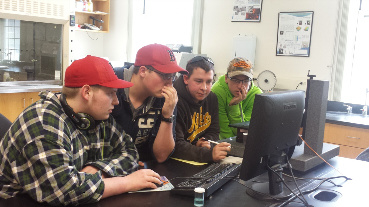
Students using the LaserScan Profilometer to measure spider web.
Visit 4: Students will visit the Scanning Electron Microscope (SEM) to look at variious biological samples which include housefly eyes, junebugs facial features and compound eye and will see the detailed uniques features of deer hair.